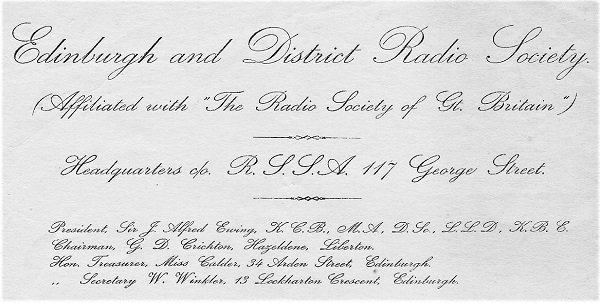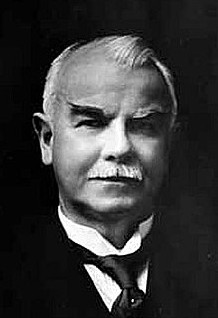The Edinburgh & District Radio Society was likely the very first radio society in Edinburgh at the beginning of the 20th century. Wikipedia states that it was run from around 1900 by Dr. James Robert Milne, FRSSA, FRSE (c1880 – 3 Feb 1961), B.Sc University of Edinburgh 1899. He lectured in physics at the University from 1912 to 1946. He was elected President of the Royal Scottish Society of Arts for 1923 to 1925. It is not stated whether the E&DRS was started before 1900 but this is unlikely as radio was only being discovered about that time.
The E&DRS shared the premises of the Edinburgh Photographic Society at 16 Royal Terrace from 1929 for some years.
Quite by chance a sheet of headed notepaper of the Edinburgh & District Radio Society was found recently in a very old radio training book “Wireless Course” by S. Gernsback, A. Lescarboura & H.W. Secor, The Electro Importing Co., New York, N.Y. ~1918, which was purchased by an LRS member.

In case you can’t quite read that, here it is again:
………………………………………………………………………………………………………………………………………………
Edinburgh and District Radio Society
(Affiliated with “The Radio Society of Great Britain”)
==========
Headquarters c/o R.S.S.A. 117 George Street.
==========
President, Sir J. Alfred Ewing, K.C.B., M.A., D.Sc., L.L.D., K.B.E.
Chairman, G. D. Crichton, Hazeldean, Liberton.
Hon. Treasurer, Miss Calder, 33 Arden Street, Edinburgh.
” Secretary W. Winkler, 13 Lockharton Crescent, Edinburgh.
………………………………………………………………………………………………………………………………………………..
The R.S.S.A. is the Royal Scottish Society of Arts, which now holds its meetings in the Augustine United Church, 41 George IV Bridge Edinburgh EH1 1EL.
………………………………………………………………………………………………………………………………………………….

Sir Alfred Ewing
The E&DRS President Sir James Alfred Ewing (27 Mar 1855 – 7 Jan 1935) was a very distinguished gentleman, laterally Principal of the University of Edinburgh from 1916 (1917?) to 1929. The following information was found in Wikipedia.
Born in Dundee in 1855, the son of a Free Church minister, Ewing won a scholarship to the University of Edinburgh where he studied physics before graduating in engineering. During his summer vacations he worked on telegraph cable laying expeditions, including one to Brazil under William Thomson, 1st Baron Kelvin, and Fleeming (sp?) Jenkin.
During World War I, from 1914 to May 1917, Ewing managed Room 40, the Admiralty intelligence department of cryptanalysis, responsible predominantly for the decryption of intercepted naval messages. In this capacity, he achieved considerable fame in the popular press when Room 40 deciphered the Zimmerman Telegram in 1917 (which suggested a German plot to assist Mexico in recovering the southwestern United States). The publication of the Zimmerman Telegram is generally credited as the trigger event which brought America into the Great War.
